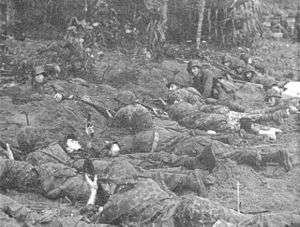Koiari Raid
| ||||||||||||||||||||||||||||||
The Koiari Raid was a battle that occurred between 28–29 November 1943 in the Pacific theater of World War II between American and Japanese forces. Part of the Bougainville campaign, the raid involved a landing by a battalion-sized force of United States Marines to harass Imperial Japanese Army troops on Bougainville Island. The raid was a failure for the Americans as they were attacked by a larger-than-expected Japanese force and as a result the Marines were withdrawn from the beachhead without having achieved any of their objectives.
Background
The US commander, General Roy Geiger, wanting to increase the beachhead perimeter that had been established around Torokina to include a ridge of hills 2,000 yards (1,800 m) away, ordered an eastward advance towards the Torokina River, aimed at establishing an inland defense line codenamed "Fox". The advance was to proceed on 26 November. In order to protect the general advance from any surprise Japanese attack on the right flank, Geiger planned a raid at Koiari, 10 miles (16 km) down the coast from Cape Torokina, to detect enemy troop movements, destroy enemy supply dumps and disrupt their line of communications. The raiders were to harass enemy units as far inland as the East–West trail but avoid any decisive engagement with major Japanese forces.[1]

The 1st Parachute Battalion, 1st Marine Parachute Regiment, under the command of Major Richard Fagan, which had just arrived from Vella Lavella, was assigned to be the main force, with 'M' Company of the 3rd Marine Raider Battalion and a forward observer team from the 12th Marine Regiment attached.[1][2] However, due to delays the raid was put back until the 29 November. Covering fire for the landing, which had been planned to be provided by destroyers, was now not available due to orders previously issued. A preliminary reconnaissance landing was undertaken in darkness on 27 November and reported no enemy activity in the area. A boat reconnoitred the beach landing site prior to the landing on 28 November and also reported no enemy activity.[2]
Raid
The 1st Parachute Battalion was transported by United States Navy LCMs and LCVPs landing craft, landing ashore at Koiari at 04:00 hours on 29 November. The landing occurred adjacent to a Japanese supply dump. The Marines overran the supply dump and hastily dug in 200 yards (180 m) yards inland, amidst heavy mortar, machine gun and rifle fire from defending Japanese. Meanwhile, 'M' Company of the 3rd Marine Raider Battalion and HQ Company were landed 0.5 miles (0.80 km) further south.[3] In order to repel the landing, the Japanese launched a number of infantry charges which caused significant casualties amongst the US forces. Close-in support fire was provided by 155 mm guns of the 3rd Defense Battalion firing from their gun lines around Cape Torokina under the control of the forward observation teams.[1] A captured 37mm field gun was also used against the Japanese.[4]
Experiencing heavy-than-expected resistance, it became clear to the US commanders that the raiders were outnumbered. With an estimated 1,200 Japanese in the immediate vicinity, the US raiding force faced annihilation. The second landing party that had been landed further south met up with the main party at 09:30 hours, having suffered 13 casualties while moving north.[3] Realizing the futility of the situation and believing that he no longer possessed freedom of action having been decisively engaged, Fagan sent a request over the radio for evacuation. Geiger concurred and ordered the Marines to be withdrawn, although a communications failure resulted in this message not getting through to Fagan.[5]
Two attempts were made to extract them by landing craft, although these failed due to heavy Japanese artillery fire. With their backs to the sea and ammunition running low amongst the troops on the beach, an LCI gunboat and the destroyers USS Fullam (DD-474), USS Lansdowne (DD-486), and USS Lardner (DD-487), which had been ordered back from convoy escort duties, closed in to the beach at 18:00 hours, and—in concert with shore based artillery and air support—provided a barrage that allowed rescue craft to remove the raiding group from the beach; the last boat left the area at 20:40 hours under the cover of darkness.[1]
Aftermath
None of the objectives of the raid were achieved and the raid was a failure with 15 killed or died of wounds, 99 wounded and 7 missing. It was estimated that the Japanese had lost about 145–291 men.[1] Again the lack of preliminary naval and artillery bombardment proved to be important in the outcome of the engagement.[6] In the aftermath of the raid, US plans to expand the perimeter around Torokina went ahead with units of the 3rd Marine Division advancing towards the Torokina River throughout early December, as part of a plan to occupy the high ground west of the river.[7] This advance would see the Marines take part in a series of engagements around Hellzapoppin Ridge and Hill 600A in mid-December.[8]
Notes
References
- Gailey, Harry (1991). Bougainville 1943–1945: The Forgotten Campaign. Lexington, Kentucky: The University Press of Kentucky. ISBN 0-8131-9047-9.
- Hoffman, Jon T. (1995). From Makin to Bougainville - Marine Raiders in the Pacific War. Washington, D.C.: Marine Corps Historical Center, United States Marine Corps. OCLC 33835536.
- Rentz, John M. (1946). Bougainville and the Northern Solomons. Washington, D.C.: Historical Branch, Headquarters, United States Marine Corps. OCLC 1313812.
- Shaw, Henry; et al. (1963). History of U.S. Marine Corps – Operations in World War II, Volume II: Isolation of Rabaul. Washington, D.C.: Historical Branch, G-3 Division, Headquarters, U.S. Marine Corps. OCLC 568751111.
